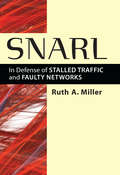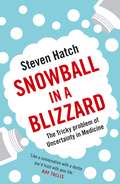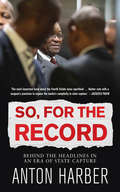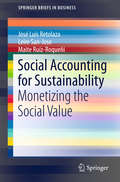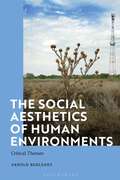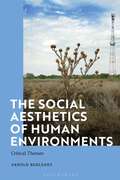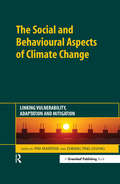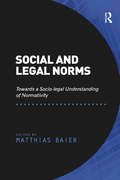- Table View
- List View
Snakes and Ladders for Property Professionals
by Frances Kaye Tanya RossThis book is for all those seeking to maximise the effectiveness of their professional relationships in order to reach the top of the property or construction industries. It is written to help young professionals at the early stages of their careers increase their understanding of others and to help more experienced practitioners gain additional skills on their way to the top. It guides you through the intricate steps of professional relationship building – internally for positive staff relationships and proactive teams as well as externally for smooth project management, delivery and business development. It contains advice that all ambitious professionals will find helpful: strategies to help you make the most of your strengths and optimise any opportunities that may present themselves. It is generously sprinkled with cases studies, some of which will cover familiar territory, others will act as a useful warning. Anyone choosing a career in the property and construction profession will benefit from reading this book. Whatever your level of seniority, the tips and tactics will help you to spot and avoid those slippery snakes and climb the ladders to the top.
Snakes and Ladders for Property Professionals
by Frances Kaye Tanya RossThis book is for all those seeking to maximise the effectiveness of their professional relationships in order to reach the top of the property or construction industries. It is written to help young professionals at the early stages of their careers increase their understanding of others and to help more experienced practitioners gain additional skills on their way to the top. It guides you through the intricate steps of professional relationship building – internally for positive staff relationships and proactive teams as well as externally for smooth project management, delivery and business development. It contains advice that all ambitious professionals will find helpful: strategies to help you make the most of your strengths and optimise any opportunities that may present themselves. It is generously sprinkled with cases studies, some of which will cover familiar territory, others will act as a useful warning. Anyone choosing a career in the property and construction profession will benefit from reading this book. Whatever your level of seniority, the tips and tactics will help you to spot and avoid those slippery snakes and climb the ladders to the top.
Snarl: In Defense of Stalled Traffic and Faulty Networks
by Ruth A MillerRuth A. Miller excavates a centuries-old history of nonhuman and nonbiological constitutional engagement and outlines a robust mechanical democracy that challenges existing theories of liberal and human political participation. Drawing on an eclectic set of legal, political, and automotive texts from France, Turkey, and the United States, she proposes a radical mechanical re-articulation of three of the most basic principles of democracy: vitality, mobility, and liberty. Rather than defending a grand theory of materialist or posthumanist politics, or addressing abstract concepts or “things” writ large, Miller invites readers into a self-contained history of constitutionalism situated in a focused discussion of automobile traffic congestion in Paris, Istanbul, and Boston. Within the mechanical public sphere created by automotive space, Snarl finds a model of democratic politics that transforms our most fundamental assumptions about the nature, and constitutional potential, of life, movement, and freedom.
Snowball in a Blizzard: The Tricky Problem of Uncertainty in Medicine
by Steven HatchLONGLISTED FOR THE THE BMA MEDICAL BOOK AWARDS According to a wry saying among radiologists, finding a tumour in a mammogram is like finding a snowball in a blizzard. Up to thirty percent of breast-cancer diagnoses are given to those who have no cancer at all. Medicine is subject to far more uncertainty than we commonly acknowledge. While it is portrayed a science, it can sometimes be scarily close to educated guesswork.Covering everything from the efficacy of Prozac to the regular barrage of health advice by the media, Snowball in a Blizzard is a profound meditation on why it's essential that doctors and their patients know what we don't know. The world is more complicated than we like to believe.Informed by years of frontline medical experience and filled with personal reflections, this important book is filled with counter-intuitive revelations about flawed reasoning, helpful guidance and hard-earned insight. It will change the way you view the health of yourself, your loved ones or your patients.
Snowfall at Willow Lake: Snowfall At Willow Lake Fireside Lakeshore Christmas (The Lakeshore Chronicles #4)
by Susan WiggsFill your winter with snowflakes, sparkles & Susan Wiggs
So, for the record: Behind the Headlines in an Era of State Capture
by Anton Harber‘Only Anton Harber, a pioneer of independent journalism in south Africa and one of the keenest observers of the media around, could have written the thriller that is this book.’ – Jacob DlaminiVeteran journalist Anton Harber brings all his investigative skills to bear on his very own profession, the media. For two years he conducted dozens of interviews with politicians, journalists, policemen, state security agents and ‘deep throats’, before piecing together two remarkable tales.The first is a chilling story of police death squads, rogue units and renditions, and how South Africa’s biggest newspaper was duped into doing the dirty work of corrupt politicians. The second starts with a broken and discarded hard drive and evolves, with many near misses, into the exposure of the depths of the Guptas’ influence over the ruling party.Harber’s two tales reveal the lows and highs of journalism during an era of state capture. His book is both a disquieting exposé of how easily the media can be duped by a conniving cabal for its own selfish ends, and a celebration of brilliant investigative reporting by brave and ethical journalists.
So, Now You Are an Arbitrator: The Arbitrator’s Toolkit
by Neil Kaplan Chiann BaoIn arbitration, procedure is crucial to ensure acceptance of the process. This book is about the importance of getting the procedure right. It begins with the first-ever request to be an arbitrator and takes the reader through all the stages of an arbitration. It points out some of the pitfalls and contains useful checklists. It gives advice on how to deal with conflicts, conduct hearings, deal with document requests, deal with experts, deal with challenges, agree on fees, draft procedural orders and awards, and how not to take on too much. Written by two experienced and highly respected international arbitrators, the book provides immeasurably valuable guidance on such details of the arbitral process as the following: terms of appointment; appointment of a tribunal secretary; steps to be taken before Procedural Order No. 1; written submissions; witnesses; third-party funding and contingency issues; keeping track of the money; interim measures; and expedited proceedings and early determination. Links to important documents are provided, and nineteen appendices include model forms for documents, agendas, orders, declarations, schedules, and protocols. Providing a veritable treasure trove of invaluable suggestions and hints which would only normally be known to arbitrators of many years’ standing, this eminently practical book will greatly enhance the ability of both new and experienced arbitrators to nip problems in the bud. It will also be of interest to counsel who appear in arbitrations and who may benefit from seeing things from the tribunal’s point of view. As this book will evolve into a ‘living’ book on the Kluwer website, the authors will continue to keep pace with developments in the field of international arbitration.
So Now You're Back (Mira Ser.)
by Heidi Rice‘Domestic Diva’ Halle Best is world famous as Queen of the Kitchen,and everything in her life is going perfectly. Until her ex comes back into the picture!
So you really want to be an Arbitrator?
by Mark CatoThis text provides a concise overview of arbitration and offers guidance on the most important legal and practical questions which face the practitioner involved in an arbitration. The book includes:- the applicability of the laws of individual countries; international conventions and bilateral treaties and their relevance to the arbitral process; the arbitration agreement and how an enforceable agreement can be created and enforced, with reference to both institutional arbitration, such as governed by AAA, ICC and LCIA and ad-hoc arbitration; and the arbitral process, from appointment of the tribunal to the award and its enforcement. The jurisdiction, powers and obligations of the tribunal are also examined in detail. The book also examines the role of UNCITRAL in overcoming the lack of unformity in the laws and rule relating to international commercial arbitration.
So you really want to be an Arbitrator?
by Mark CatoThis text provides a concise overview of arbitration and offers guidance on the most important legal and practical questions which face the practitioner involved in an arbitration. The book includes:- the applicability of the laws of individual countries; international conventions and bilateral treaties and their relevance to the arbitral process; the arbitration agreement and how an enforceable agreement can be created and enforced, with reference to both institutional arbitration, such as governed by AAA, ICC and LCIA and ad-hoc arbitration; and the arbitral process, from appointment of the tribunal to the award and its enforcement. The jurisdiction, powers and obligations of the tribunal are also examined in detail. The book also examines the role of UNCITRAL in overcoming the lack of unformity in the laws and rule relating to international commercial arbitration.
SOC for Supply Chain: Reporting on an Examination of Controls Relevant to Security, Availability, Processing Integrity, Confidentiality, or Privacy in a Production, Manufacturing, or Distribution System, 2020 (AICPA)
by AICPAInternal and external forces such as globalization, global interconnectivity, automation, and other technological advancements are making today’s supply chains highly sophisticated and complex. For organizations that produce, manufacture or distribute products, there’s often a high level of interdependence and connectivity with their suppliers and their customers and business partners. Although the interconnectedness of these organizations can be beneficial (increased revenues, expanded market opportunities, and cost reduction), the ability of organizations to meet their goals is often increasingly dependent on events, processes, and controls that are not visible and are often beyond their control – such as a supplier’s controls. That’s why the demand for transparency in supply chains is now higher than ever before, and why this is the perfect time for you to help organizations assess their supply chain risks, evaluate the system controls within their manufacturing, production, or distribution systems, and communicate their supply chain management efforts to those with whom they do business. Accountants and financial managers can also increase the credibility of the supply chain information communicated by the organization by providing an opinion on the organization’s supply chain efforts. This guide enables the accountant and financial manager to examine and report on the description of a system for manufacturing, producing and distributing goods as well as on the controls within that system using a dynamic, proactive, and agile approach. It will show how to conduct this examination in accordance with the attestation standards. The guide may also be helpful when providing readiness assessments to clients, who are not quite ready for an examination level service and need help to get there. The guide also includes excerpts from the two distinct, but complementary sets of criteria developed by the AICPA to assist practitioners with SOC for Supply Chain engagements: the description criteria and the 2017 trust services criteria.
SOC for Supply Chain: Reporting on an Examination of Controls Relevant to Security, Availability, Processing Integrity, Confidentiality, or Privacy in a Production, Manufacturing, or Distribution System, 2020 (AICPA)
by AICPAInternal and external forces such as globalization, global interconnectivity, automation, and other technological advancements are making today’s supply chains highly sophisticated and complex. For organizations that produce, manufacture or distribute products, there’s often a high level of interdependence and connectivity with their suppliers and their customers and business partners. Although the interconnectedness of these organizations can be beneficial (increased revenues, expanded market opportunities, and cost reduction), the ability of organizations to meet their goals is often increasingly dependent on events, processes, and controls that are not visible and are often beyond their control – such as a supplier’s controls. That’s why the demand for transparency in supply chains is now higher than ever before, and why this is the perfect time for you to help organizations assess their supply chain risks, evaluate the system controls within their manufacturing, production, or distribution systems, and communicate their supply chain management efforts to those with whom they do business. Accountants and financial managers can also increase the credibility of the supply chain information communicated by the organization by providing an opinion on the organization’s supply chain efforts. This guide enables the accountant and financial manager to examine and report on the description of a system for manufacturing, producing and distributing goods as well as on the controls within that system using a dynamic, proactive, and agile approach. It will show how to conduct this examination in accordance with the attestation standards. The guide may also be helpful when providing readiness assessments to clients, who are not quite ready for an examination level service and need help to get there. The guide also includes excerpts from the two distinct, but complementary sets of criteria developed by the AICPA to assist practitioners with SOC for Supply Chain engagements: the description criteria and the 2017 trust services criteria.
Social Accounting for Sustainability: Monetizing the Social Value (SpringerBriefs in Business)
by José Luis Retolaza Leire San-José Maite Ruíz-RoqueñiThis book deals with the limitations of economic and financial accounting as an appropriate instrument to reflect the real value created or destroyed by an organization. The authors present a sustainable social accounting approach that considers both the social and economic value – Blended Value – generated by an organization for all of its stakeholders. This approach is based on four major theories – Stakeholder Theory, Action Research, Phenomenological Perspective and Fuzzy Logic – and was developed on the basis of a cost-benefit analysis.
The Social Aesthetics of Human Environments: Critical Themes
by Arnold BerleantAcross these essays Arnold Berleant demonstrates how aesthetic values and theory can be used to reappraise our social practices. He tackles issues within the built environment, everyday life, and politics, breaking down the dichotomy between the natural and the human. His work represents a fresh approach to traditional philosophical questions in not only ethics, but in metaphysics, truth, meaning, psychology, phenomenology, and social and moral philosophy. Topics covered include the cultural aesthetics of environment, ecological aesthetics, the aesthetics of terrorism, and the subversion of beauty. The corruption of taste by the forces of commercial interests as well as how aesthetics can advance our understanding of violence are also considered. Berleant's exploration is supported by his analysis of 19th-century art to the present day, starting with impressionism through to postmodernism and contemporary artistic interventions. By critically examining the field in this way and casting new light on social understanding and practice, this collection makes a substantive contribution in identifying and clarifying central human issues, guided by an understanding of aesthetic engagement as a powerful tool for social critique.
The Social Aesthetics of Human Environments: Critical Themes
by Arnold BerleantAcross these essays Arnold Berleant demonstrates how aesthetic values and theory can be used to reappraise our social practices. He tackles issues within the built environment, everyday life, and politics, breaking down the dichotomy between the natural and the human. His work represents a fresh approach to traditional philosophical questions in not only ethics, but in metaphysics, truth, meaning, psychology, phenomenology, and social and moral philosophy. Topics covered include the cultural aesthetics of environment, ecological aesthetics, the aesthetics of terrorism, and the subversion of beauty. The corruption of taste by the forces of commercial interests as well as how aesthetics can advance our understanding of violence are also considered. Berleant's exploration is supported by his analysis of 19th-century art to the present day, starting with impressionism through to postmodernism and contemporary artistic interventions. By critically examining the field in this way and casting new light on social understanding and practice, this collection makes a substantive contribution in identifying and clarifying central human issues, guided by an understanding of aesthetic engagement as a powerful tool for social critique.
The Social and Behavioural Aspects of Climate Change: Linking Vulnerability, Adaptation and Mitigation
by Pim Martens Chiung Ting ChangOver the past few years, and certainly since the publication of the "Stern Report", there has been increasing recognition that climate change is not only an environmental crisis, but one with important social and economic dimensions. There is now a growing need for multi-disciplinary research and for the science of climate change to be usefully translated for policy-makers.Until very recently, scientific and policy emphasis on climate change has focused almost exclusively on mitigation efforts: mechanisms and regulations to reduce greenhouse gas emissions. The success of such efforts to date is debatable. In fact, the impact of ever more stringent emission control programmes could potentially have enormous social consequences. Little effort has been expended on the exploration of a systematic evaluation of climate stabilization benefits or the costs of adapting to a changed climate, let alone attempting to integrate different approaches. There is an increasing recognition that the key actors in the climate crisis also need to be preparing for change that is unavoidable. This has resulted in a greater consideration of vulnerability and adaptation.The book, based on the research programme "Vulnerability, Adaptation and Mitigation" (VAM) which ran from 2004 to 2010, funded by the Netherlands Organisation for Scientific Research (NWO), presents a cluster of case studies of industries, communities and institutions which each show how vulnerability, adaptation and mitigation analyses can be integrated using social behavioural sciences. Each chapter makes specific recommendations for the studied industry sector, community or institution, analyses the latest research developments of the field and identifies priorities for future research. The book argues that the inherent complexity of climate change will ultimately require a much more integrated response both scientifically – to better understand multiple causes and impacts – as well as at the scientific/policy interface, where new forms of engagement between scientists, policy-makers and wider stakeholder groups can make a valuable contribution to more informed climate policy and practice.The book is particularly timely as the scientific research and policy debate is shifting from one of problem-framing to new agendas that are much more concerned with implementation, the improvement of assessment methodologies from a multi-disciplinary perspective, and the reframing of current scientific understanding towards mitigation, adaptation and vulnerability. A critical element in responding to the climate change challenge will be to ensure the translation of these new scientific insights into innovative policy and practice "on the ground". This book provides some fundamental elements to answer this need.The Social and Behavioural Aspects of Climate Change: Linking Vulnerability, Adaptation and Mitigation will be essential reading for social science researchers and policy managers in the area of climate change, as well as for those who want to know what the social and behavioural sciences can contribute toward coping with climate hazards. NGOs, law firms and businesses in the energy sector or other climate related fields will also find the book of great value.
The Social and Behavioural Aspects of Climate Change: Linking Vulnerability, Adaptation and Mitigation
by Pim Martens Chiung Ting ChangOver the past few years, and certainly since the publication of the "Stern Report", there has been increasing recognition that climate change is not only an environmental crisis, but one with important social and economic dimensions. There is now a growing need for multi-disciplinary research and for the science of climate change to be usefully translated for policy-makers.Until very recently, scientific and policy emphasis on climate change has focused almost exclusively on mitigation efforts: mechanisms and regulations to reduce greenhouse gas emissions. The success of such efforts to date is debatable. In fact, the impact of ever more stringent emission control programmes could potentially have enormous social consequences. Little effort has been expended on the exploration of a systematic evaluation of climate stabilization benefits or the costs of adapting to a changed climate, let alone attempting to integrate different approaches. There is an increasing recognition that the key actors in the climate crisis also need to be preparing for change that is unavoidable. This has resulted in a greater consideration of vulnerability and adaptation.The book, based on the research programme "Vulnerability, Adaptation and Mitigation" (VAM) which ran from 2004 to 2010, funded by the Netherlands Organisation for Scientific Research (NWO), presents a cluster of case studies of industries, communities and institutions which each show how vulnerability, adaptation and mitigation analyses can be integrated using social behavioural sciences. Each chapter makes specific recommendations for the studied industry sector, community or institution, analyses the latest research developments of the field and identifies priorities for future research. The book argues that the inherent complexity of climate change will ultimately require a much more integrated response both scientifically – to better understand multiple causes and impacts – as well as at the scientific/policy interface, where new forms of engagement between scientists, policy-makers and wider stakeholder groups can make a valuable contribution to more informed climate policy and practice.The book is particularly timely as the scientific research and policy debate is shifting from one of problem-framing to new agendas that are much more concerned with implementation, the improvement of assessment methodologies from a multi-disciplinary perspective, and the reframing of current scientific understanding towards mitigation, adaptation and vulnerability. A critical element in responding to the climate change challenge will be to ensure the translation of these new scientific insights into innovative policy and practice "on the ground". This book provides some fundamental elements to answer this need.The Social and Behavioural Aspects of Climate Change: Linking Vulnerability, Adaptation and Mitigation will be essential reading for social science researchers and policy managers in the area of climate change, as well as for those who want to know what the social and behavioural sciences can contribute toward coping with climate hazards. NGOs, law firms and businesses in the energy sector or other climate related fields will also find the book of great value.
Social and Economic Rights in Africa: International and Public Law Perspectives (Routledge Studies on Law in Africa)
by Nsongurua UdombanaSocial and economic rights have hitherto been marginalised in mainstream legal and political discourses and treated as second-class citizens in the human rights family. These rights are now receiving increasing attention in law and politics, arguably because they raise existential questions on human security and dignity. This one-stop volume examines the international and public law perspectives on socio-economic rights in Africa. Working on the premise that these rights are normative and justiciable, the author methodically and expertly examines the legal frameworks for their protection in global, regional, and national instruments, infusing the analysis with African and comparative jurisprudence. The author also examines the nature of obligations on these rights as well as the interpretive methodologies that should be deployed towards their realisation. In blending theory with practice, the book also refl ects on some governance challenges that continue to hobble the eff ective realisation of these rights in Africa. The book is a seminal contribution on an important fi eld, an ideal companion for human rights practitioners, international and constitutional lawyers, judges, government advisors, students, social workers, and everyone who desires ‘freedom from fear and want’.
Social and Economic Rights in Africa: International and Public Law Perspectives (Routledge Studies on Law in Africa)
by Nsongurua UdombanaSocial and economic rights have hitherto been marginalised in mainstream legal and political discourses and treated as second-class citizens in the human rights family. These rights are now receiving increasing attention in law and politics, arguably because they raise existential questions on human security and dignity. This one-stop volume examines the international and public law perspectives on socio-economic rights in Africa. Working on the premise that these rights are normative and justiciable, the author methodically and expertly examines the legal frameworks for their protection in global, regional, and national instruments, infusing the analysis with African and comparative jurisprudence. The author also examines the nature of obligations on these rights as well as the interpretive methodologies that should be deployed towards their realisation. In blending theory with practice, the book also refl ects on some governance challenges that continue to hobble the eff ective realisation of these rights in Africa. The book is a seminal contribution on an important fi eld, an ideal companion for human rights practitioners, international and constitutional lawyers, judges, government advisors, students, social workers, and everyone who desires ‘freedom from fear and want’.
Social and Economic Rights in Theory and Practice: Critical Inquiries (Routledge Research in Human Rights Law)
by Helena Alviar García Karl Klare Lucy A. WilliamsSince World War II, a growing number of jurisdictions in both the developing and industrialized worlds have adopted progressive constitutions that guarantee social and economic rights (SER) in addition to political and civil rights. Parallel developments have occurred at transnational level with the adoption of treaties that commit signatory states to respect and fulfil SER for their peoples. This book is a product of the International Social and Economic Rights Project (iSERP), a global consortium of judges, lawyers, human rights advocates, and legal academics who critically examine the effectiveness of SER law in promoting real change in people’s lives. The book addresses a range of practical, political, and legal questions under these headings, with acute sensitivity to the racial, cultural, and gender implications of SER and the path-breaking SER jurisprudence now emerging in the "Global South". The book brings together internationally renowned experts in the field of social and economic rights to discuss a range of rights controversies from both theoretical and practical perspectives. Contributors of the book consider specific issues in the litigation and adjudication of SER cases from the differing standpoints of activists, lawyers, and adjudicators in order to identify and address the specific challenges facing the SER community. This book will be of great use and interest to students and scholars of comparative constitutional law, human rights, public international law, development studies, and democratic political theory.
Social and Economic Rights in Theory and Practice: Critical Inquiries (Routledge Research in Human Rights Law)
by Helena Alviar García Karl Klare Lucy A. WilliamsSince World War II, a growing number of jurisdictions in both the developing and industrialized worlds have adopted progressive constitutions that guarantee social and economic rights (SER) in addition to political and civil rights. Parallel developments have occurred at transnational level with the adoption of treaties that commit signatory states to respect and fulfil SER for their peoples. This book is a product of the International Social and Economic Rights Project (iSERP), a global consortium of judges, lawyers, human rights advocates, and legal academics who critically examine the effectiveness of SER law in promoting real change in people’s lives. The book addresses a range of practical, political, and legal questions under these headings, with acute sensitivity to the racial, cultural, and gender implications of SER and the path-breaking SER jurisprudence now emerging in the "Global South". The book brings together internationally renowned experts in the field of social and economic rights to discuss a range of rights controversies from both theoretical and practical perspectives. Contributors of the book consider specific issues in the litigation and adjudication of SER cases from the differing standpoints of activists, lawyers, and adjudicators in order to identify and address the specific challenges facing the SER community. This book will be of great use and interest to students and scholars of comparative constitutional law, human rights, public international law, development studies, and democratic political theory.
Social and Environmental Dimensions of Organizations and Supply Chains: Tradeoffs and Synergies (Greening of Industry Networks Studies #5)
by Marcus Brandenburg Gerd J. Hahn Tobias RebsThis book focuses on environmental and social factors in international supply chains and industry networks. It explores whether socially-responsible and environmentally-conscious operations are complementary or conflictive to economic targets. The book elaborates on innovative approaches to manage the economic, ecological and social performance in supply networks from different perspectives. In addition, it links sustainability to operational processes and illustrates specific application contexts. Moreover, it covers the social dimension of sustainability. The rise of sustainability in management forces enterprises to revisit the concept of profitability that drives their operations. Social standards and ecological targets represent critical factors that challenge industry networks. The interplay of these goals requires new insights from scientific research and managerial practice. New approaches and systems are needed to minimize environmental and social harms and to promote sustainability.
Social and Legal Norms: Towards a Socio-legal Understanding of Normativity
by Matthias BaierIn an era where new areas of life and new problems call for normative solutions while the plurality of values in society challenge the very basis for normative solutions, this book looks at a growing field of research on the relations between social and legal norms. New technologies and social media offer new ways to communicate about normative issues and the centrality of formal law and how normativity comes about is a question for debate. This book offers empirical and theoretical research in the field of social and legal norms and will inspire future debate and research in terms of internationalization and cross-national comparative studies. It presents a consistent picture of empirical research in different social and organizational areas and will deepen the theoretical understanding regarding the interplay between social and legal norms. Including chapters written from four different aspects of normativity, the contributors argue that normativity is a result of combinations between law in books, law in action, social norms and social practice. The book uses a variety of different international examples, ranging from Sweden, Uzbekistan, Colombia and Mexico. Primarily aimed at scholars in sociology of law, socio-legal studies, law and legal theory, the book will also interest those in sociology, political science and psychology.
Social and Legal Norms: Towards a Socio-legal Understanding of Normativity
by Matthias BaierIn an era where new areas of life and new problems call for normative solutions while the plurality of values in society challenge the very basis for normative solutions, this book looks at a growing field of research on the relations between social and legal norms. New technologies and social media offer new ways to communicate about normative issues and the centrality of formal law and how normativity comes about is a question for debate. This book offers empirical and theoretical research in the field of social and legal norms and will inspire future debate and research in terms of internationalization and cross-national comparative studies. It presents a consistent picture of empirical research in different social and organizational areas and will deepen the theoretical understanding regarding the interplay between social and legal norms. Including chapters written from four different aspects of normativity, the contributors argue that normativity is a result of combinations between law in books, law in action, social norms and social practice. The book uses a variety of different international examples, ranging from Sweden, Uzbekistan, Colombia and Mexico. Primarily aimed at scholars in sociology of law, socio-legal studies, law and legal theory, the book will also interest those in sociology, political science and psychology.
Social And Political Foundations Of Constitutions (Comparative Constitutional Law And Policy Ser. (pdf))
by Denis J. Galligan Mila VersteegThis volume analyses the social and political forces that influence constitutions and the process of constitution making. It combines theoretical perspectives on the social and political foundations of constitutions with a range of detailed case studies from nineteen countries. In the first part leading scholars analyse and develop a range of theoretical perspectives, including constitutions as coordination devices, mission statements, contracts, products of domestic power play, transnational documents, and as reflection of the will of the people. In the second part these theories are examined through in-depth case studies of the social and political foundations of constitutions in countries such as Egypt, Nigeria, Japan, Romania, Bulgaria, New Zealand, Israel, Argentina and others. The result is a multidimensional study of constitutions as social phenomena and their interaction with other social phenomena.

